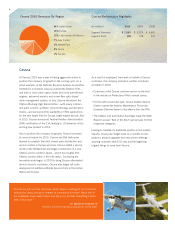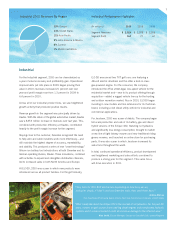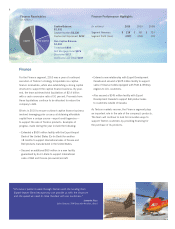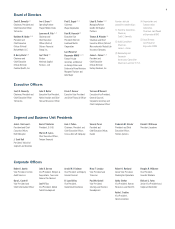E-Z-GO 2010 Annual Report Download - page 18
Download and view the complete annual report
Please find page 18 of the 2010 E-Z-GO annual report below. You can navigate through the pages in the report by either clicking on the pages listed below, or by using the keyword search tool below to find specific information within the annual report.6
Orders remain in backlog until the aircraft is delivered or upon cancellation by the customer. Upon cancellation, deposits are used to
defray costs, including remarketing fees, cost to reconfigure the aircraft and other costs incurred as a result of the cancellation.
Remaining deposits, if any, may be retained or refunded at our discretion.
Approximately 58% of our total backlog at January 1, 2011 represents orders that are not expected to be filled in 2011.
The U.S. Government is obligated only up to the amount of funding formally appropriated for a contract. The difference between the
award value of the contract and the amount formally appropriated (funded) represents unfunded backlog. At January 1, 2011,
substantially all U.S. Government backlog included in the above table was funded. Under a multi-year procurement contract with the
U.S. Government for the purchase of V-22 tiltrotor aircraft, Bell has $4.9 billion of funded backlog included in the above table. Bell
also has approximately $1.2 billion of unfunded orders under the V-22 program that have not yet been appropriated and are not
included in the above table.
U.S. Government Contracts
In 2010, approximately 34% of our consolidated revenues were generated by or resulted from contracts with the U.S. Government.
This business is subject to competition, changes in procurement policies and regulations, the continuing availability of funding, which
is dependent upon congressional appropriations, national and international priorities for defense spending, world events, and the size
and timing of programs in which we may participate.
Our contracts with the U.S. Government generally may be terminated by the U.S. Government for convenience or if we default in
whole or in part by failing to perform under the terms of the applicable contract. If the U.S. Government terminates a contract for
convenience, we normally will be entitled to payment for the cost of contract work performed before the effective date of termination,
including, if applicable, reasonable profit on such work, as well as reasonable termination costs. If, however, the U.S. Government
terminates a contract for default, generally: (a) we will be paid the contract price for completed supplies delivered and accepted, an
agreed-upon amount for manufacturing materials delivered and accepted and for the protection and preservation of property, and an
amount for partially completed products accepted by the U.S. Government; (b) the U.S. Government will not be liable for our costs
with respect to unaccepted items and will be entitled to repayment of advance payments and progress payments related to the
terminated portions of the contract; and (c) we may be liable for excess costs incurred by the U.S. Government in procuring
undelivered items from another source.
Research and Development
Information regarding our research and development expenditures is contained in Note 1 to the Consolidated Financial Statements on
page 50 of this Annual Report on Form 10-K.
Patents and Trademarks
We own, or are licensed under, numerous patents throughout the world relating to products, services and methods of manufacturing.
Patents developed while under contract with the U.S. Government may be subject to use by the U.S. Government. We also own or
license active trademark registrations and pending trademark applications in the U.S. and in various foreign countries or regions, as
well as trade names and service marks. While our intellectual property rights in the aggregate are important to the operation of our
business, we do not believe that any existing patent, license, trademark or other intellectual property right is of such importance that its
loss or termination would have a material adverse effect on our business taken as a whole. Some of these trademarks, trade names and
service marks are used in this Annual Report on Form 10-K and other reports, including: AAI; AH-1Z; BA609; Bell/Agusta
Aerospace Company, LLC; Bell Helicopter; Bravo; Cadillac Gage; Caravan; Caravan Amphibian; Caravan 675; Cessna; Cessna 350;
Cessna 400; Citation; CitationAir; CitationAir Jetcard; Citation Encore+; Citation Sovereign; Citation X; Citation XLS+; CJ1+; CJ2+;
CJ3; CJ4; CLAW; Corvalis; Eclipse; Excel; E-Z-GO; Fly Bell; Fly Smart; Grand Caravan; Greenlee; H-1; Huey II; IE2; Kautex;
Kiowa Warrior; Klauke; Lycoming; M1117 ASV; McCauley; Mustang; Next Generation Fuel System; NGFS; Overwatch; Paladin;
PDCue; Power Advantage; Progressive; ProParts; Rothenberger LLC; RXV; Sensor Fuzed Weapon; Shadow; SkyBOOKS;
Skycatcher; Skyhawk; Skyhawk SP; Skylane; SkyPLUS; Sovereign; Stationair; ST 4X4; Super Cargomaster; SuperCobra; SYMTX;
TDCue; Tempo; Textron; Textron Defense Systems; Textron Financial Corporation; Textron Global Technology Center; Textron
Marine & Land Systems; Textron Systems; Turbo Skylane; Turbo Stationair; UAV SYSTEMS SPECIALIST; UH-1Y; US Helicopter;
V-22 Osprey; 2FIVE; and 429. These marks and their related trademark designs and logotypes (and variations of the foregoing) are
trademarks, trade names or service marks of Textron Inc., its subsidiaries, affiliates or joint ventures.
Environmental Considerations
Our operations are subject to numerous laws and regulations designed to protect the environment. Compliance with these laws and
expenditures for environmental control facilities has not had a material effect on our capital expenditures, earnings or competitive
position. Additional information regarding environmental matters is contained in Note 15 to the Consolidated Financial Statements on
page 79 of this Annual Report on Form 10-K.
We do not believe that existing or pending climate change legislation, regulation, or international treaties or accords are reasonably
likely to have a material effect in the foreseeable future on our business or markets nor on our results of operations, capital
expenditures or financial position. We will continue to monitor emerging developments in this area.
























